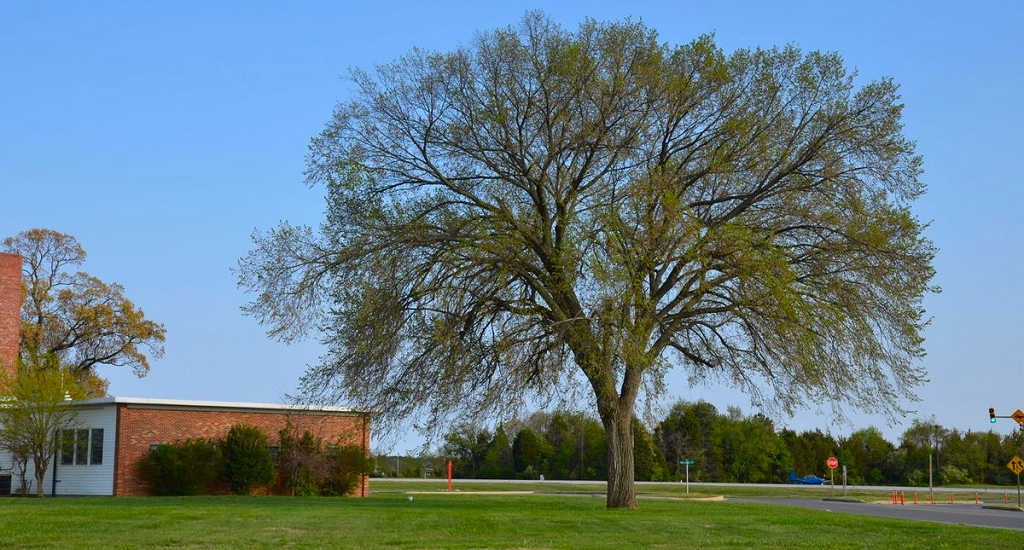PATUXENT RIVER, Md. (April 20, 2017)—From coast to coast, American elms were the tree of choice to line Main Street USA because of their spreading canopies that gracefully arched across roadways and shaded residents below.
"Cedar Point Road aboard NAS Patuxent River was also once lined with American elm trees from Route 235 to the water, and along Millstone Road from Cedar Point to Millstone Landing," said Kyle Rambo, Pax River's conservation director. "They were a very common tree here, but we've lost hundreds of them on the installation due to Dutch elm disease."
Dutch elm disease is a lethal fungus that was introduced in the United States by accident in the 1930s via infected logs from Europe. Spread by bark beetles, it has been responsible for the deaths of American elm trees by the hundreds of thousands throughout the country.
"We've been watching them go and it's a painful thing to see; like a piece of America that's disappearing," Rambo said. "There are some elms left on Cedar Point Road but you can tell they're sick. They're bigger, gnarly-looking trees with dead limbs and sap weeping down the sides of the trunk. There are some expensive treatments, but once the fungus has spread within them, it's really a losing battle."
Pax's protector of the species
There is one American elm tree, however � located on Millstone Road between the Marine Aviation Detachment and Ground Electronics Maintenance � that is large, has a beautiful crown spread, and appears to be perfectly healthy.
"It shows no signs of decline and senescence like the other elm trees have," Rambo noted. "And since we know the trees used to line Millstone Road, it isn't because it was far away from any others and never had the opportunity to be infected. The only thing I can surmise is that is has some kind of genetic resistance and, as such, could prove important for the future of the species."
Rambo explained there are a number of groups working to find genetically resistant trees to either grow for propagation, or to crossbreed with other individuals to come up with more disease resistant strains. He has made it a special campaign to try to save this lone tree and offer up both seeds and cuttings to nurseries, arboretums, state forestry agencies and anyone else interested in it.
"Responses are just now beginning to come back to me; but there's interest," Rambo said. "I've been in touch with the University of Maryland agricultural extension; the National Arboretum in Washington, D.C., which is actually operated by the U.S. Department of Agriculture; and then there's a private organization called the American Phytopathological Society, whose members include scientists from government agencies, academia and private practice. I've joined some of their forums and discussion groups to let them know about our material."
The protector needs our protection
At Pax River, airfield safety criteria calls for any tree to be cut down that poses an impediment to airfield safety.
"Wherever trees block the air traffic control tower's line of site to a landing surface, helo pad or road crossing, we must address the situation," Rambo added. "In this case, the healthy tree is in the tower's line of sight where Cedar Point Road crosses Alpha Taxiway and impedes their view � for a brief moment � when an aircraft is taxiing."
As a result, in order to remain standing, the elm required an exception and waiver to those airfield safety rules and, so far, the base commanding officers have been willing to honor it, beginning with former NAS Commanding Officer Capt. Heidi Fleming and continuing with current NAS Commanding Officer Capt. Scott Starkey.
"Capt. Starkey agrees the tree is important; it's special and it's one of those things that makes Pax River special," Rambo added. "We're going to do what we can to save it, and if it does have resistance, to share it with others."
Pax River's healthy tree is by no means the only one in the country, Rambo said, but trees grow in various hardiness zones and a tree that grows in Maryland may not do well in northern Minnesota, so there may be a need to cultivate resistant species from each zone.
Meanwhile, in an effort to replace the American elms lost to disease, the installation has been planting a different species that resembles them, a non-native elm-like tree called Zelkova.
"Zelkova has a similar growth form with smaller elm shaped leaves, but it's highly resistant to Dutch elm disease," Rambo said. "They grow quickly when they're young, but will slow to medium growth upon middle age and maturity. Eventually, their branch tips will touch and they'll form a shade canopy above Cedar Point Road."
Pax River American Elm Tree May Help Save Species

Located next to the Marine Aviation Detachment near the corner of Cedar Point Road and Taxiway Alpha, the lone healthy American elm tree aboard NAS Patuxent River may help save its species, which has been decimated by Dutch elm disease. (U.S. Navy photo by Donna Cipolloni)


